Simrad RS35 VHF & HS35 wireless handset, testing pretty well
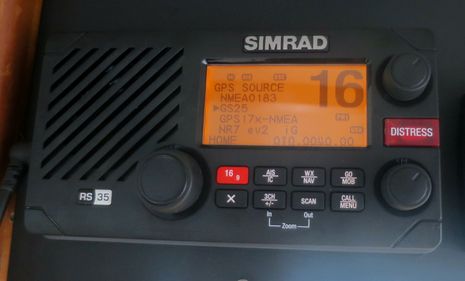 It’s taken a while but I am becoming quite fond of the Simrad RS35 VHF radio and HS35 wireless handset accessory. Panbo first covered the RS35’s nice combination of full Class D VHF DSC capabilities, NMEA 2000 interface and built-in AIS receiver in late 2012. But when I received a test unit last summer, it was quickly apparent that the radio had trouble interfacing with many N2K GPS sources (as you can read about in the comments to that 2012 entry). I was slow to return the radio for the software fix, but now it’s installed at Gizmo’s lower helm and has no problem with the three GPS sources shown above and a lot more I threw at it. I’ve also seen it output AIS info over NMEA 2000 to every MFD currently on Gizmo (though there is a glitch if you also have a transponder, explained below). And while some interesting radios have come to market in the last year, the RS35 at about $300 to $350 seems the VHF/AIS/N2K value leader (except for its sibling Lowrance Link-8 if you don’t care about the wireless handset option)…
It’s taken a while but I am becoming quite fond of the Simrad RS35 VHF radio and HS35 wireless handset accessory. Panbo first covered the RS35’s nice combination of full Class D VHF DSC capabilities, NMEA 2000 interface and built-in AIS receiver in late 2012. But when I received a test unit last summer, it was quickly apparent that the radio had trouble interfacing with many N2K GPS sources (as you can read about in the comments to that 2012 entry). I was slow to return the radio for the software fix, but now it’s installed at Gizmo’s lower helm and has no problem with the three GPS sources shown above and a lot more I threw at it. I’ve also seen it output AIS info over NMEA 2000 to every MFD currently on Gizmo (though there is a glitch if you also have a transponder, explained below). And while some interesting radios have come to market in the last year, the RS35 at about $300 to $350 seems the VHF/AIS/N2K value leader (except for its sibling Lowrance Link-8 if you don’t care about the wireless handset option)…
At first I was disappointed that the RS35 does not have the channel tagging feature I’ve enjoyed on Icom, Standard Horizon and Garmin radios. I like to eavesdrop on VHF, especially when alone on the boat, and tagging is the ultimate way to scan all the channels you want and none of the ones you don’t. However, I’m pretty happy with the Simrad’s 3 CH ALL SCAN mode, which actually flips through 3 favorites and channel 16. TRIWATCH gets you one favorite plus 16 and 9 (if you’ve set up Watch Mode that way), and there’s also an ALL SCAN mode that checks 16 every 2 seconds and has a handy SKIP feature to temporarily eliminate open channels. The speaker sound is good and the RS35 seems as good at bringing in distant stations as any recreational VHF I’ve tried.
Now about that screen. The RS35 manual warns that screen viewing is optimal only within 20 degrees up or down, left or right. I find it better than that if you push backlighting and contrast to their maximum values. But photographing the display well is hard, as illustrated above, and you may need your reading glasses for some screens like AIS. It is big, though, and I’m enjoying how much nav info it’s showing, including bearing and distance to Gizmo’s float since I input the waypoint.
The AIS screen is informative and you can quickly select targets and get even more info on them with the main rotary/click knob (great to have volume and squelch knobs, too). You can also zoom in and out of the graphic target plot with the 3CH and SCAN keys. Note, though, that you can not scan while viewing the AIS screen, and that the RS35 cannot place direct DSC calls to AIS targets. That feature is planned for a future software update, though, and the update will be possible over NMEA 2000 from a Simrad MFD. Also slated for that update is the ability to ignore your own vessel if you are running an AIS transponder. As shown, the test RS35 constantly sees Gizmo as a very nearby target and would be sounding loud CPA/TCPA alarms if I hadn’t turned them off completely. The same issue was true of Garmin, Furuno, and Raymarine MFDs, where I was always closely followed by my own AIS target, but is not a problem on a Simrad or Lowrance MFD because they’ve long had the ability to accept and filter out an “own vessel” MMSI. You can also simply turn off the RS35’s AIS receiver, keeping it in reserve until your transponder fails or the update comes out.
I tried every type of direct DSC calling possible between the RS35 and the ever wonderful Standard Horizon HX851 handheld (850 reviewed here), but they both have the same MMSI number, which may have affected the results. Individual calls worked fine both ways, as did position requests. But the RS35 would not accept a Position Send from the HX, and would not enable “Buddy Tracking” with it. The Simrad manual doesn’t say that Buddy Tracking only works with other Simrad radios, but then again, it doesn’t say much about the feature. Anyone know? Sorry for another poor photograph but it does suggest the nice key backlighting on this radio.
When I requested a position from the HX851, the Simrad radio placed a waypoint for it on the Simrad NSS7 evo2 that’s on the same NMEA 2000 network, and I’m confident that it would do something similar if I received a DSC distress call. However, I don’t know why “Grounding” was placed in the waypoint notes. I hope to do further experimentation, particularly to see if DSC positions are sent to other MFDs and am hoping other users will chime in.
In my view, one of the main reasons to consider a Simrad RS35 — or maybe the newer blackbox RS90 premium model — is the chance to use the HS35 wireless mic. My habit now is to turn on the base station with volume down and work around the boat with HS35 clipped to my pocket or sitting nearby. It, too, has good sound as well as a complete set of fast-acting keys, and I’ve yet to experience any wireless issues anywhere on this 37 foot boat (which has lots of other wireless activity). I was a little skeptical about the inductive charging, especially as I can feel the heat generated, but a meter check indicated low amperage drain and the fact that the charger seems to shut down completely when done. The AIS screen below definitely calls out for my reading glasses, but then again, you can put a wireless mic like this right up to your eyes or ear and mouth. We’re day one on a week-long cruise during I which I plan to use this radio and mic a lot, so I may be adding more observations in the comment section.


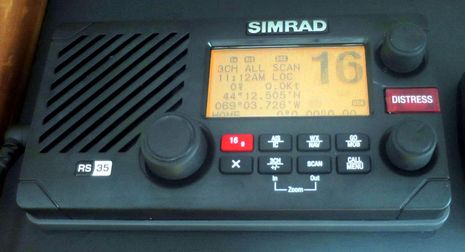
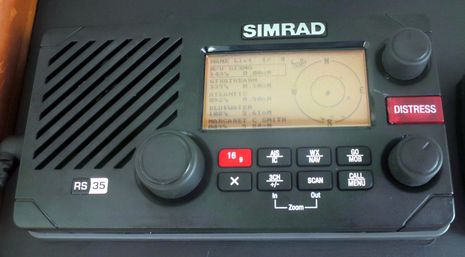
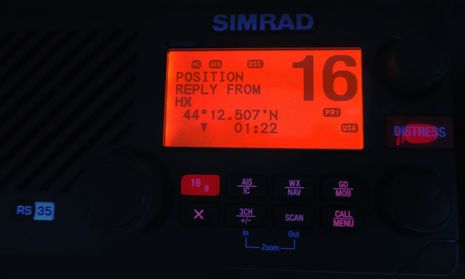
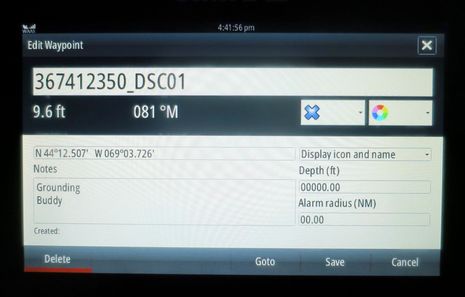
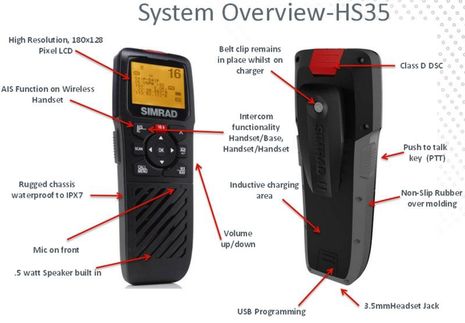
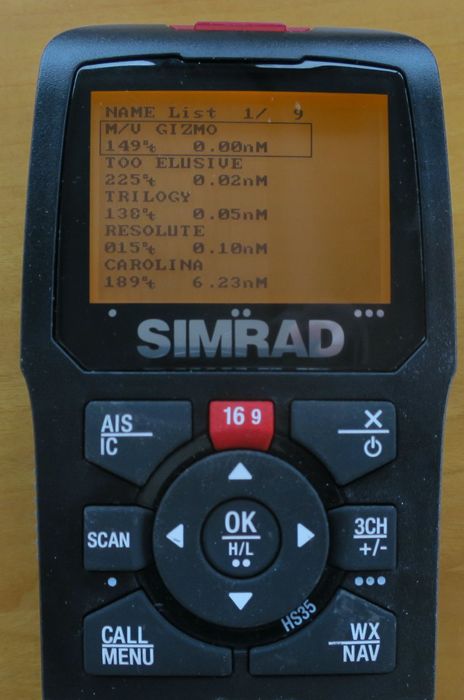
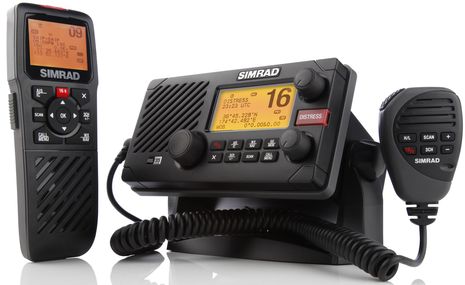

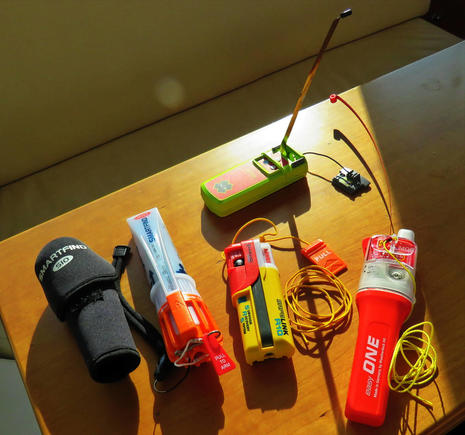









“Note, though, that you can not scan while viewing the AIS screen, and that the RS35 cannot place direct DSC calls to AIS targets. That feature is planned for a future software update, though, and the update will be possible over NMEA 2000 from a Simrad MFD.”
Ben,
Any clue as to timing for the updates?
Don
I’m curious how the wireless mic performs when water gets in the microphone and in wind. I have an older uniden wireless microphone and in rain and wind listeners can barely understand what you are saying. I’m a bit disappointed with your comments on the screen readability. With today’s technology it’s cheap to put a good screen on a piece of gear. Also, the fact that you can’t program more than a few favorites for scanning is also disappointing. I regularly scan 5 or 6 channels in addition to 16 – especially when transiting New York Harbor.
Ben,
I recently installed the RS35, RS90 and HS35. One problem that I have found and can repeat is to press the AIS button to get to the Hailer menu. My HS35 locks up and none of the buttons work.
This has been with the HS35 connected to the RS90. I will test with the RS35 this weekend.
I wish the RS90 had an interface on the NSO evo2.
Sort of like the Fusion Link, so I could change channels and mute without having to pull the RS90 handset from the mounting bracket.
Hey,
I recently installed the RS/HS35 combo. I have a garmin GPSMAP740 plotter and the radio / garmin unit communicate easily and nicely.
I am seeing one strange problem; every now and then the RS35 will turn off and then back on. I can’t figure out why, and none of my other instruments (Raymarine autopilot, garmin plotter, raymarine instreuments) have this problem. The RS35 comes back up in a few minutes, but it’s still annoying.
My radio has the 1.12 firmware.
Anyone else see similar behavior?
Barry
Don, no clue on update schedule but will ask.
Chris, will try to test wind and wet, may have a good chance during tonight’s frontal passage.
Henry, I haven’t attached a hailer yet, and it may be a while…
Barry, on startup my test radio briefly shows “S/W Ver: 1.112” which may be what you mean? I have not seen shut downs during a fair amount of use.
So darn odd that I received a DSC call I didn’t make myself yesterday. I hardly ever get them up here, and heard very few going 1,000 miles down the coast and back in ’12-’13.
At any rate it was an All Ship Safety message possibly sent by a nearby USCG buoy tender. I was right in the middle of a tight channel full of pot buoys and mainly wanted the loud klaxon noise to stop. I’m not sure which key on the HS35 handset worked but I know that it did not stop the base station at the lower helm from ringing, and the handset was locked up while the base station rang. It did time out before I got down there, and the handset worked again, but it wasn’t a good DSC experience.
On a brighter note, I just took the HS35 with me in Gizmo’s new tender — I scored a gently used 9′ Fatty Knees with sailing rig last weekend! — and it worked fine until I got about 400 feet away and behind a large boat. And it hooked back up with the base station as soon as I got clear of the obstruction. Impressive.
I use the SH GX2000 with the RAM3 Mic in the cockpit. Both get regular use. I have received several safety DSC calls all over Europe and a great lot in the Canaries where they send a DSC call to announce the maritime and safety information broadcasts – really annoying. On both the GX2000 and the RAM3, when a call is received, the rightmost softkey becomes “QUIT”. A first press silences the alarm but all call information remains displayed for you to read in peace and quiet. A second press clears the display and returns you to the normal screen.
A quit on one station immediately silences the alarm on the other station as well. When the call information is cleared from one station’s screen, it is also cleared from the other’s screen.
From a useability perspective, I wouldn’t know how to improve this.
I have not tried if channel scanning stops while the AIS screen is displayed as I don’t use this but normal calls certainly work while the AIS screen is up.
Position requests work well between the GX2000 and the HX851. I use it with Coastal Explorer which places a red dot on the chart. There is no problem with the MMSI number being the same between the GX2000 and the HX851.
You can call AIS targets. However, there are a maximum of 10 targets displayed (descending by proximity). You can’t scroll down a longer list. Also, the “range” of the AIS display must be set and this works as a filter for the list display also. The maximum range setting is 15nm. This means that you can’t display and consequently can’t call AIS targets more then 15nm away. This is not as big an issue as I find to use this feature much less that I had expected.
The bad part with the SH radio is the lack of NMEA2000. Technically, it doesn’t even have NMEA0183 as the wires are RS232 not the RS422 mandated by NMEA0183 (I read this has been changed on newer SH radios). There are two separate inputs. One is fixed to 4800 baud, the other 38400. The GPS sentences are expected on the 4800 port and if the GPS sentences come in on the high speed port, then no position is available. In short: all the old problems of NMEA0183 combined in one product.
I am interested in the RS90. Will you get one to test? If I hear of no problems with it, I will switch back to Simrad in a year or two.
Upgraded my 1992 Autohelm instruments to all new Raymarine on my 42 foot sailboat last year. Was excited when I saw the Standard Horizon VHF AIS radio. Almost ready to bite. Then saw the Simrad RS35 with N2K and wireless remote. I’ve been a SH customer for 35+ years but two things sold me on the Simrad: connector plugs instead of individual little wires (makes removal for winter much easier) and higher resolution display. After a couple calls and emails (good support from Navico) it works great. But some comments and reviews on the HS35 made me balk at that. I just ordered one now, thanks to your review.
We like our HS35 and RS35, which we have sailed from Fla. to Mass.
I like that I can see our NAIS-400 AIS tx on the HS35 because it’s good AIS radio check. Hopefully they will have the option to continue to do this check after the sw update.
Things which we question and perhaps Ben can help with:
1. On long sails, the battery of the HS35 wears down and its charging dock is not at the helm nor were we able to locate it there because of its questionable aesthetics when the HS35 is undocked and because of the ergonomics of our particular cockpit when the HS35 is docked.
Question: if we buy an extra B&G H50 handset, will it work seamlessly with our RS35? (The B&G V50 is just a relabeled RS35 that was not available for sale when we went all-B&G big time last year) (RS35/V50 can handle multiple HS35/V50)
2. The HS35/V50 have a mini-stereo audio jack plug at the bottom. We want to use the HS35/V50 as a backup/redundant system to our crew’s wireless intercom system. However, we have tested the following and do not work or give only audio on only one ear:
(a) iPhone mic/headset. Mic does not work on HS35. Noise on one ear only.
(b) Simultalk mic/headset. Plug fits but no joy at all, noise only.
(c) Regular consumer headset, no mic. Audio on one ear only.
I called Navico and at first they did not seem to realize there is a headset plug at the bottom, with “headset” icon on the waterproof rubber plug, and documented in the manual. After several calls, they said the plug is only for “listening” and one needs to raise the whole HS35/V50 to mouth to speak. Nonsense, I say (on only one ear?). Of course you would still need PTT, makes sense.
Question:I just want the protocol number/spec for the correct headset and I’ll order my headsets from Europe if I have to.
3. We have the current software on RS35, as our original unit could not be updated. Glitches that persist:
(a) The squelch on the HS35 will revert to whatever the physical button squelch the RS35 has, at random times that can be from five minutes to many hours, but wherein this revert seems to be related to the quantity of third-party traffic on the airwaves, and that may be related to…
(b) Yesterday, coincidentally, I was facing the nav station when the RS35 rebooted! By itself! Quietly! Stealthily! Since we are hardly ever there, how often has this happened in the last year? The RS35 had been “on” continuously for 96 hours when this happened.
4. Adjusting the backlight on the HS35 changes the backlight on the RS35. These two are in different light environments, so not cool.
Other than that, great radio. Don’t think there is anything better on the market, yet (other than the V50, of course).
Navico should enable direct DSC calling from our Zeuses, though.
Standard Horizon support advised that DSC functions between RED’s GX2100 and our handheld HX851 would not work unless the MMSI numbers were different.
Our solution is that RED’s dingy now has its own MMSI which is in the HX851. DSC calling, including position reports both way work as designed.
It is useful to know that your boat hasn’t dragged anchor or where your shore party is at the moment.
Cheers,
Richard D
s/v RED
Mini stereo plug? Apparently it’s for a wired remote mic. Hmm, wired remote mic for a wireless remote handset. Anyway, try this link:
http://www.defender.com/pdf/259473_Brochure.pdf
About two months ago I experimented with the response of a chart plotter–an HDS-8–to digital selective calling data from a DSC Classs-D radio. I noted the rather unusual response “Grounding Buddy” which the Lowrance HDS-8 produced after getting data from another vessel in reply to a DSC position request call. This seemed like an unfortunate mixing of official and unoffical categories of call. See
http://continuouswave.com/whaler/reference/DSC_ChartPlotter.html
for more details.
Richard D:
Regarding using identical MMSI in a ship’s main VHF and a DSC handheld belonging to the ship: AFAIK the UK’s authorities are issuing MMSI numbers with a special prefix to DSC handhelds which are mobile and not (technically) tied to a specific boat. Germany (my jurisdiction) doesn’t do this but instead registers handheld DSCs to a ship and the handheld is not only allowed but required to have the same MMSI. Personally I prefer the UK way (as I do so many times when it comes to boating) but this means I cannot get a MMSI for my HX851.
I therefore tried using the same MMSI with my SH GX2000/HX851 combination without asking SH support and found it to be working perfectly.
– the GX2000 is not answering it’s own position request
– the HX851 does answer a position request for the MMSI it is itself programmed to
– the GX2000 sends a NMEA0183 DSC + DSE sentence combination which is understood by Coastal Explorer which is what I use as a chart plotter.
Jim Hebert:
I am not really happy with a waypoint representing the location of a DSC caller on an MFD chart display and I frowned when I read this for a Lowrance plotter in the entry above. It might make sense if you want to be able to navigate to it quickly but I suspect it is more a shortcut taken by the programmers to avoid having to introduce a new type of data object.
Coastal Explorer does not use a waypoint but a simple red dot with the caller’s MMSI displayed next to it. The dot moves with subsequent reports from this same MMSI (no string of dots is building) and Reports from new MMSIs get their own dot. All dots stay in place until CE is restarted. The dot does not contain any more information, though the time of the call, the nature of the call (distress, urgency, routine) or if it was a reply to position request would be good to know. I would like to see this and it is on Rose Point’s todo list but the current state satisfies my needs. If I want to navigate to that location, it is easy to drop a waypoint.
On DSC alerts in general:
We are in the Solent (around the Isle of Wight), United Kingdom at the moment. Last evening there was a false alert issued as a DSC distress call. Costal Explorer’s red dot told me it came form an alongside berth in Cowes harbor so I dismissed it immediately and this was confirmed later by Solent Coastguard. I have read that the vast majority of DSC alerts turn out to be false but I don’t have a major problem with this as normally it is quickly established if it is a real emergency or not. In every case you always have a position to work with.
Conversely, just this moment Solent Coastguard is trying to contact a station having sent a weak Mayday voice call. There is no answer and they have no position to check so there may be a real emergency in an area with plenty of shipping, numerous official ships and the best rescue services you are likely to find anywhere, none of whom can do anything.
In reply to Henning:
I am glad your read my article about response of chart plotters to DSC messages. It seems that in the design of the DSC system, there are strict standards that govern most aspects of the interconnections of humans and machines or machines to machines, except in the case of the final link, the data to a display or chart plotter from a DSC radio. There does not seem to be any standard for that connection in a recreational grade display or chart plotter. Apparently every manufacturer is making up their own method.
You may enjoy the other three articles in my series of DSC-related tests.
Test of an older DSC radio, rated to the RTCM SC-101 standard:
http://continuouswave.com/whaler/reference/DSC_DistressTest.html
Test of a Class-D DSC radio, with much better outcome:
http://continuouswave.com/whaler/reference/DSC_DistressTest2.html
Very detailed analysis of the data created by a DSC radio and sent to other devices:
http://continuouswave.com/whaler/reference/DSC_Datagrams.html
Regarding the “3.5mm Headset jack” in the bottom of the RS-35: –It sounds like that jack is monaural instead of stereo..:-( Finding a headset to plug in won’t be easy (check with scanner shops) – or you could construct/buy an adapter.
Capn Willy,
Thank you so very much for the .pdf link!
So the HS35/H50 does support a PTT wired headset thru the 3.5mm jack at the bottom, exactly as it should be!
And they actually put that on their salesforce training materials! Maybe I’ll send the .pdf to the Navico 1-800 guys. They told me the jack is for a pair of headphones only.
Now, where do you think I might get a headset with a 3.5mm plug, with three segments, where the first segment accepts a 470 µF (or pF) for PTT, and the 2nd and 3rd segment are for the earphone at 32 ohm? And is there a standard name for this?
I’m curious, since the RS35 and Link-8 basically share the same hardware and are running the same software, have the issues relative to the weather channels been resolved here in the US? I’m VERY interested in the Link-8 and plan to pair it up with my NSS8 and NSS12 EVO2 but I’d like a unit that’s known to be the least problematic. The ICOM M506 is a great unit, but VERY pricey for the recreational boater. My primary use in going to be in/near shore within 10 miles.
So how is the Link-8 newer versions of late?
Ben,
Have you heard of anyone else with the HS35 freeze if trying to use the hailer?
This past weekend, my RS35 started playing the weather channels about every 2 hours. I did not notice if the unit had power cycled. Each time the display showed channel 16 but was playing a weather channel. The RS90 did not do this.
No I haven’t, Henry, and don’t have a hailer hooked up myself.
But I did have the unexpected weather report issue and made it go away by turning off weather alerts. Not an ideal solution but hopefully one of several issues that will be fixed in a coming RS35 update ;=)
Ben, question for you. I am reconsidering the RS35 VHF.
To alleviate some space issues on my center console, I would mount this INSIDE of my console. I would use the HS35 handset solely.
My question is the quality/clarity and volume of the internal speaker on the HS35. I don’t want to keep crawling in and out of the console to play with the volume level on the RS35. Thus, I would turn the volume on the RS35 basically off to mute it and only use the handset.
Realistically, is the speaker quality and sound levels up to par and “as good as” the RS35? If not, I’ll have to rethink this.
Thanks
Hi Thomas,
I use the handset standalone a lot and am happy with it.
But am motoring down Long Island Sound right now and just compared speakers side by side.
the RS35 does have a bigger, fuller sound but handset is still darn good, also easy to hold up to your ear.
Back on 24 July 2014, I posted:
‹‹ On long sails, the battery of the HS35 wears down and its charging dock is not at the helm nor were we able to locate it there because of its questionable aesthetics when the HS35 is undocked and because of the ergonomics of our particular cockpit when the HS35 is docked.
Question: if we buy an extra B&G H50 handset, will it work seamlessly with our RS35? ››
The answer, it turns out, is YES. The H50, the RS35, and the HS 35 subscribed right away and chatted happily among themselves.
By the way, Navico, where are the promised firmware updates? Soon it’s going to have been a year!
I am considering the RS35. I have both an intercom and a hailer. Both units are usable with my current icom VHF. Does the Simrad RS35 have a feature to allow use with a two way intercom?
Marshall, the RS35 has a “30 W Hailer with listen back capability” (which I haven’t tried) and intercom between wireless handset and base station that works well (with second handset supported). But if you mean integration with some other intercom system, I don’t know about that (though I’m curious).
Do note, though, that at least my test RS35 has an odd AIS glitch that I documented here:
https://panbo.com/archives/2014/10/mfd_and_ais_anomalies_be_careful_out_there.html
And Simrad has not yet updated the RS35 so that you can easily place DSC direct calls to AIS targets.
For what it’s worth, I installed dual RS35s in my boat. Both failed, as in they went stone dead, within 24hrs of being powered on. I replaced one and it too went stone dead within 24 hrs. That was it for the RS35 for me. Replaced with Icom M506s
Also for what it’s worth, I have an RS35 on my boat and have two portables, an HH33 and an HH36. All have individual MMSI’s. The RS35 can make MMSI calls to the HH33 and HH36. The HH33 can call the HH36 and visa-versa. But NO WAY can I make the RS35 receive calls from either of the portables. So I tested on another RS35 and same thing. What gives????? Haven’t tested on a 3rd party VHF to the RS35.
Leslie, I found with my Standard Horizon HX851 that I had a similar problem (HX851 would not register and ring on incoming DSC call). I returned it for an exchange twice until I finally found an undocumented setting of “DSC” where you normally switch between “USA” and “INTL” regional channel settings. Only if I set this to the undocumented 3rd setting “DSC” would the radio work, i.e. react to an incoming call.
Such a setting does not make sense as DSC signalling works with radios both set to USA channels or international channels and is is not exlusive with both.
Maybe you have a similar problem.
Thanks for that. In Australia we set VHF to INTL and it was the first thing Simrad support asked me to check.
Hello berry…. i got that same problem. the rs35 just resets itself. Is very anoying whike scanning, since it stols the scan. Did you figure lut how to solve this problem? Simrad support completly ignores any questions.
Hi
I have already 3rd. RS35 and allways with the same problem, it reboots itself if you have the a scannig ( DW, 3-watch or scan all) and the AIS functioning at same time. Navico have changed my gear three times but the failure still exists. RS35 is working with similar way alltough it’s connected with the power from an external source or from the boat (i.e. no power failure). Navico has promissed an update for the SW for a year ago but still never seen (current SW 1.112).
This kind of rebooting failure should navico fix ASAP!
Hannu, your problem is strange to me. I use Triwatch and 3CH All Scan a lot and don’t ever recall a reset. I use both the main set, software V1.112, and the HS, V1.031. I don’t very often use the AIS screen but I can’t get to them without “X”ing out of scan mode. However the RS35 is always outputting AIS info over NMEA 2000 and that’s never been a problem except the very weird name scrambling issue I documented last fall:
https://panbo.com/archives/2014/10/mfd_and_ais_anomalies_be_careful_out_there.html
I saw that again during my trip north, but it only happens when there are lots of targets and even then it only messes up one or two. There’s no doubt, though, that this radio really needs a software update, and strange that Simrad has let it go so long.
Same here.
Alway’s om 3ch watch, never an issue.
Wrong AIS names, AIS targets with missing letters, same shipnames for various vessels, pushed me to turn AIS on the VHF off.
Too dangerous, if you call a vessel on crashcourse with the wrong name.
We stopped using the RS35 on tri-watch because it crashed often. Mind you, often you as the user would not be aware that it had crashed, as it looked “fine”; however, it often would have ceased to receive, or would appear to transmit but in fact would not.
When we need to monitor a second frequency, we pull out an Icom handheld.
The promised software update would be good news.
Itzmann,
Part of your post has me wondering.
I have an RS35 that seems to be intermittent on transmit. Some times it works, sometimes it does not. I have been chasing the problem first trying to find a pattern and testing if I have an antenna problem.
We not just use the RS35 for listening a secondary channel. I called Simrad and have started turning off features – AIS was first, to see I can find the source or conflict.
How can you tell if your radio has “crashed”. It does appear to be fine but does not transmit.
Henry
We realised the RS35 was not transmitting after a couple of hairy situations in the New River in Fort Lauderdale:
1 A bridge attendant started screaming at us for lack of response (even though we thought we were responding via the RS35), and fortunately had a portable on deck that we were able to quickly put to use to respond to the bridge operator.
2 We initiated a dialog with a megayacht before approaching a curve and a bridge, and agreed on an unusual starboard (us) to port (them) pass on a day with a lot -a lot- of river traffic. The megayacht subsequently called to reverse request to a regular port to port pass, which we rejected, as we had already made our mind, set course, etc. Three times they called, three times we responded with our negative. We ended up starboard to port but very nearly head-on immediately after the curve. Fortunately all involved were skilled and cautious, so we simply inched our way forward. I belatedly realised they never heard our three negatives.
To clarify to any skeptics, yes, we were pressing the PTT button. These are the two clearest examples I can cite of the failure, and there is little room for misinterpretation or other operator error because the communications were ongoing/repeated and the failure is evident beyond doubt. But the radio has failed in several other cases, less evident, in a similar manner.
Our standard operating procedure is:
1) In the ocean in long passages with little VHF traffic: turn on and off the radio once every 24 hrs (and it still has been found crashed, for instance, in that the radio’s AIS is definitively crashed, because it fails to pick up our own signal coming from a NAIS-400).
2) When approaching a harbour, a foggy patch, or other sketchy circumstance: turn radio on/off just to ensure it is “fresh” and uncrashed.
3) When there is heavy/continuous third party VHF traffic, turn on/off once in a while.
4) The sole functions “on” on the radio are AIS, single channel monitoring, DSC enabled (MMSI entered), and display time and long/lat. We find that turning on anything else makes the radio extremely unreliable.
The radio is nearly always used via a remote HS35, and almost never via its native controls. Could have something to do with the issues, but does not excuse Simrad.
Cheerio,
Hi Ben
Do you have had the AIS function on the same time as the scanning? The scan works well if there is no AIS function “on” on the same time.
The worst of this rebooting phenomen is that the radio stays after start-up on random channel, not on f.ex. ch16 as it works if it would have had power-up.
The rebooting happens irregular, somtimes after some minutes sometimes after some hours!Very irritating failure.
I belive I am not the only one with this problem, but Navico seems to ignore all my questions about it.
Again I’m confused by what you mean when you say “had the AIS function on the same time as the scanning.”
The AIS receive function is always on, so yes it’s on whenever I scan.
But the AIS display function is never on while scanning. On my RS35 the AIS Display button does not work if the radio is doing any kind of scanning. The only way I know how to display AIS targets on the radio is to first put it in single channel mode.
Hi Ben
Sorry if my explanation was a little bit confusing. I mean with AIS function “On” that I have choosen from the AIS Menu the AIS function “on”. Then you should be able to see on the basic display a small icon on the screen “AIS”. You can also choose AIS “off”. In the off state you are not able to see anything from the AIS display and your small icon “AIS” is also disapearing from the basic display. This means that I have switched off the AIS function.
The problem exits if I have choosen the AIS “on” and I have swithed on somekind of scannig (DW, 3-watch or scan all) to work.
If the AIS is on the “off” state, I have never seen this reboot phenomen. The sw version is 1.112
I hope you’ll now understand my problem a little better.
Thanks for the clarification, but now we have even more evidence that this is an inconsistent bug. I use scanning a lot with AIS on and never see a reboot, even though your radio and mine are running the same software version. And Hendrik and Itzmann seem to have had the same opposite experiences from their comments above. Maybe Navico has had trouble fixing this problem because they can’t locate it?
Ben,
My RS35 seems to have finally stopped working. I tried turning it on/off, and turned off AIS completely. It would receive but would not transmit. I tested with both the TowBoat automated radio checks, another boat approx. 1/2 a mile away and a marina about 3 miles away. My RS90 worked fine, the RS35 did not. I swapped antenna cables to be sure. No change.
I contacted SIMRAD Tech Support who did not even ask any questions or try to trouble shoot. They simply wanted to know the serial number and issued me an RMA to return the radio to San Diego. Once it is received, they will contact me as to what they find and what the repair cost will be or if they will issue me a refurbished unit.
I asked if there was an option to do a unit swap so I could have a working radio while cruising the ICW and I was told no, first they needed to evaluate the problem.
I am very disappointed in SIMRAD’s support and approach to dealing with an item that I feel is critical for the operation of the boat. When the SonarHub froze during a software update, they shipped me one immediately.
I wish the VHF radios had some standardization of sizing. Now I am looking for a unit that will fit in the hole left by the RS35, even if I have to put a plastic plate around it.
New software is available at the Simrad Yachting website
Thanks, Hendrik! Direct link here:
http://www.simrad-yachting.com/en-US/Support/Downloads/RS35-Software-Update/
Hope to try very soon.
RS35 updates went well over N2K, but I only noticed this at the end of the process:
“If you have a HS35 wireless handset it will also need to be updated to V2.84 in order for the handset to operate correctly with RS35, this will require the HS35 to be returned to a Navico authorized dealer for updating as it can not be updated in the field.”
However, my test HS35 handset hooked up fine to the updated RS35 and most functions seems to work OK. The notable exception is the AIS screen, which comes up completely blank, though it does call up a proper AIS screen on the RS35.
Now the question is “what does this update do for the radio?” I don’t notice anything yet, and couldn’t find the direct DSC call to AIS target feature I was hoping for.
Another bit I missed on the update page, expanded on by a Simrad email:
“Just to clarify the DSC calling feature is initiated from a Simrad, B&G and Lowrance MFD that is connected to a RS35,V50, RS90 or V90 and soon the Link-8- you just touch the vessel icon on the MFD to highlight it, then touch the vessel Name and you will see the Call option under the AIS Vessel Details by selecting this you can then choose the channel you want to send with your DSC call.
In regards to the HS35, as you have seen it will still connect and have basic operation with the RS35 but for full functionality it needs to be updated ( unfortunately this can not be done in the field”
First read, then install;-)
Did that, but installed it anyhow, including the Rs35 part for the HS35.
All still worked.
Will visit Navico ELC or Simrad dealer next week to get the HS35 upgraded
Hi Ben
My RS35 was updated with the new software (2.84) and the problems with the rebooting when the AIS function is “on” at the same time with the scanning is now solved. The radio works fine! I’m glad.
The update was made by the local Navico service with their updating tool.
B.R. Hannu
I’ve tried one direct DSC call to an AIS target from a Simrad NSS16 evo2 and it seemed to work fine. The RS35 was set up to make the call on the channel I chose on the NSS and it only took one button press to place the call. I wrote “seemed” though because the boat I called did not respond. I’ll try again, hopefully with a boat that has a VHF with the same MMSI as their AIS and an operator who knows how to accept direct DSC calls. But that situation should get better as more and more boats can easily place this sort of call.
Hi, I also have had the problem of hang and need to reboot RS35 when scanning.The problem always happened when using HS35. I now NEVER scan when using the HS35.
Hi,
Do you know if it’s possible to use a raymarine MFD to update the RS35? If so, what is the procedure?
Thx,
Sorry, Simon, not possible. Marine electronics firmware updates across brands over NMEA 2000 or Ethernet are just not happening, and may never happen. There’s neither a standard way to do it, nor a motive for the major manufacturers to do it.
On the other hand, this belated RS35 update is the first time a VHF radio has been updateable in the field, I think.
Ben,
We installed a RS90, RS35 and a HS35 last in May 2014. The RS35 stopped transmitting in May 2015. I sent it back to Simrad and they shipped me a different unit. The new unit has a software glitch where the radio broadcasts weather alerts and forecasts randomly, even though the unit is on Channel 16 or 13. (it might happen on other channels but I have not tested it). Although I have only had the new radio installed for 2 months, Simrad support has advised me that I need to remove the radio from the boat and send it back to them, for them to update the software on the radio. What does not make sense, is that there is a new software update available on the Simrad site for this radio that I can apply via my plotter. Are there two pieces of software on the radio?
Our HS35 has recently broke with the transmit button no longer clicking when you push on it. It feels like a hardware problem and is being sent back on RMA.
Sorry to hear all that, HenryD. Judging from this comment thread, the RS35 may be Simrad’s most troubled product in recent years. The test unit on Gizmo, though, is going strong (it is at the lower station, so not exposed to weather at all).
Hi Henry,
Yes there are two types of software on the radio, the part that is not field up-gradable (and shouldn’t need to be upgraded) is the setting of the channel names and frequency bands. These differ from region to region. Europe (EU) has sub groups to work with ATIS regulations. US / Canada have the Weather channels and AU is for the rest of the world. Once set they should not need changing.
Ben,
My radio is installed in an enclosed pilot house, it is not exposed to weather at all.
I received an email from Navico today that they had thought the engineers had a solution but they now are advising that it is still under development. I will report back when I get notified that the software is available to the dealers. My dealer has the USB to NMEA2000 cable to do the upgrade. Since the upgrade is done via the NMEA2000 port, I am not sure why it must be done by the a dealer.
I wish the Icom 506 was a bit shorter, it would fit in the RS35 hole.
Hi, I finaly got my RS 35 updated to version 2,84 and so far, it seems to solve issues related to ”rebooting” and switching to wx channels. Next days will confirm that!
Anyone knows if it’s possible to install a wired mic to this VHF? One from another brand? Should I go with the HS 35…is it the only option?
I would prefer to have a wired mic to avoid problems with battery charge….!
Regards
If you have a Navico MFD and N2K network you can run the up date your self. The 2.84 Version is on the Simrad web site to download. The remote handset (HS35) will need to go to a dealer to be upgraded.
I assume you ask if it’s possible to install a wired second station, it already has a wired mic. No, HS35 is the only option for extra handset.
I’ve just updated the RS35 on both my boats to v2.84. Both HS35 handsets has been back to the distributor for software update. Haven’t used the new version that much, but no problems observed so far, but I did not have any issues prior to the update either. I updated to be able to initiate DSC calls from NSS Evo2.
I tested initiating DSC calls from NSS Evo2 today, then it’s just one push on RS35 or HS35 to confirm. Works as expected, great function.
I considered that a great function, too, but found that at the end of our sabbatical I had not used it once. It’s just that voice-calling big ships on channel 16 is what everyone does, has always done and apparently will do for the foreseeable future.
On each of the about 5 times I called a big ship at sea, I always got an immediate voice response on 16. So that’s what I will continue to do until such a time that I begin receiving DSC calls now and then.
Bottom line for me: a nice-to-have function but not worth taking any kind of disadvantage for in another area of your systems decision. Certainly not enough to justify an “all from one vendor”-decision.
On the other hand, being able to DSC-poll the position of your own DSC handheld radio from your ship’s radio is a far more valuable function for me.
Does that work with the RS35 and any existing handheld?
Well – I have a RS35 as well with the software prior to 2.84. Today much to my surprise I turned it on and it issued an Emergency/Distress call. Note I never lifted the plastic tab or touched that area. After frantically trying to cancel it (did not work), I ended up spending 20 minutes speaking with the coast guard and assuring them I was OK.
They issued the call with my MMSI – thats when I responded. Weird and Im not sure why this would have happened as I am sure you need to raise the plastic protector and push the button.
Based in Miami – was at the Key Biscayne bridge when this happened.
Will try the update – Im also getting the annoying switch to WX forecast
Alex
I just purchased and installed the B&G V50 VHF and H50 wireless unit. As far as I can tell this is very similar to the Simrad RS35 but with updated software. I had an RS35 on my previous boat and had problems with it.
The B&G unit has been absolutely flawless for the last 3 months, and the issues I had with the RS35 would have cropped up by now. Very happy with the overall result.
Wrote up my experience at https://www.sailbits.com/blog/2016/05/bg-v50-vhf-radio-h50-wireless-handset/
Look, B&G has mmaaannyy simply RAW issues as it was not cooked to the end to be finished and sold… Ignore all the problems, simply call the dealer and they will replace the device. sailing boat have lost autopitol in 2014 and completely FAILED constantly, no logical explanations possible. Our devices where changed 3 times….. and ALWAYS something must fail for ANY reason….
We bought the B&G version V50 with wireless handset H50 and had zero problems. Other N2K devices in use include Airmar, Maretron, Simrad, Furuno, Vesper and B&G and they all play nice.
Anybody out there know what’s going on with the Simrad RS 35 and associated wireless handset? It’s currently listed as out of stock on the Simrad site. Does this mean out of production or what?
Navico says that there’s no meaning to the RS-35 being out of stock except that it’s out of stock.